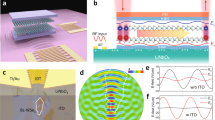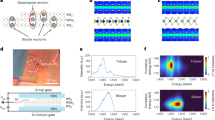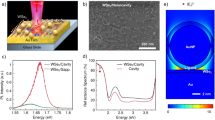Abstract
Engineering the coupling between fundamental quantum excitations is at the heart of quantum science and technologies. An outstanding case is the creation of quantum light sources in which coupling between single photons and phonons can be controlled and harnessed to enable quantum information transduction. Here we report the deterministic creation of quantum emitters featuring highly tunable coupling between excitons and phonons. The quantum emitters are formed in strain-induced quantum dots created in homobilayer WSe2. The colocalization of quantum-confined interlayer excitons and terahertz interlayer breathing-mode phonons, which directly modulates the exciton energy, leads to a uniquely strong phonon coupling to single-photon emission, with a Huang–Rhys factor reaching up to 6.3. The single-photon spectrum of interlayer exciton emission features a single-photon purity >83% and multiple phonon replicas, each heralding the creation of a phonon Fock state in the quantum emitter. Due to the vertical dipole moment of the interlayer exciton, the phonon–photon interaction is electrically tunable to be higher than the exciton and phonon decoherence rate, and hence promises to reach the strong-coupling regime. Our result demonstrates a solid-state quantum excitonic–optomechanical system at the atomic interface of the WSe2 bilayer that emits flying photonic qubits coupled with stationary phonons, which could be exploited for quantum transduction and interconnection.
This is a preview of subscription content, access via your institution
Access options
Access Nature and 54 other Nature Portfolio journals
Get Nature+, our best-value online-access subscription
$29.99 / 30 days
cancel any time
Subscribe to this journal
Receive 12 print issues and online access
$259.00 per year
only $21.58 per issue
Buy this article
- Purchase on Springer Link
- Instant access to full article PDF
Prices may be subject to local taxes which are calculated during checkout




Similar content being viewed by others
Data availability
The data that support the findings of this study are available from the corresponding author upon reasonable request.
References
Aspelmeyer, M., Kippenberg, T. J. & Marquardt, F. Cavity optomechanics. Rev. Mod. Phys. 86, 1391–1452 (2014).
Lee, K. C. et al. Entangling macroscopic diamonds at room temperature. Science 334, 1253–1256 (2011).
Vivoli, V. C., Barnea, T., Galland, C. & Sangouard, N. Proposal for an optomechanical Bell test. Phys. Rev. Lett. 116, 070405 (2016).
Tarrago Velez, S., Sudhir, V., Sangouard, N. & Galland, C. Bell correlations between light and vibration at ambient conditions. Sci. Adv. 6, eabb0260 (2020).
Mirhosseini, M., Sipahigil, A., Kalaee, M. & Painter, O. Superconducting qubit to optical photon transduction. Nature 588, 599–603 (2020).
Bienfait, A. et al. Phonon-mediated quantum state transfer and remote qubit entanglement. Science 364, 368–371 (2019).
Toninelli, C. et al. Single organic molecules for photonic quantum technologies. Nat. Mater. 20, 1615–1628 (2021).
Chen, W. et al. Continuous-wave frequency upconversion with a molecular optomechanical nanocavity. Science 374, 1264–1267 (2021).
Aharonovich, I. & Toth, M. Quantum emitters in two dimensions. Science 358, 170–171 (2017).
Lee, C. et al. Anomalous lattice vibrations of single- and few-layer MoS2. ACS Nano 4, 2695–2700 (2010).
Zhao, Y. et al. Interlayer breathing and shear modes in few-trilayer MoS2 and WSe2. Nano Lett. 13, 1007–1015 (2013).
Palacios-Berraquero, C. et al. Large-scale quantum-emitter arrays in atomically thin semiconductors. Nat. Commun. 8, 15093 (2017).
Branny, A., Kumar, S., Proux, R. & Gerardot, B. D. Deterministic strain-induced arrays of quantum emitters in a two-dimensional semiconductor. Nat. Commun. 8, 15053 (2017).
Parto, K., Azzam, S. I., Banerjee, K. & Moody, G. Defect and strain engineering of monolayer WSe2 enables site-controlled single-photon emission up to 150 K. Nat. Commun. 12, 3585 (2021).
Peyskens, F., Chakraborty, C., Muneeb, M., Van Thourhout, D. & Englund, D. Integration of single photon emitters in 2D layered materials with a silicon nitride photonic chip. Nat. Commun. 10, 4435 (2019).
Sortino, L. et al. Bright single photon emitters with enhanced quantum efficiency in a two-dimensional semiconductor coupled with dielectric nano-antennas. Nat. Commun. 12, 6063 (2021).
Kundrotas, J. et al. Impurity-induced Huang–Rhys factor in beryllium δ-doped GaAs/AlAs multiple quantum wells: fractional-dimensional space approach. Semicond. Sci. Technol. 22, 1070–1076 (2007).
Grosso, G. et al. Low-temperature electron–phonon interaction of quantum emitters in hexagonal boron nitride. ACS Photonics 7, 1410–1417 (2020).
Li, D. et al. Exciton–phonon coupling strength in single-layer MoSe2 at room temperature. Nat. Commun. 12, 954 (2021).
Ergeçen, E. et al. Magnetically brightened dark electron–phonon bound states in a van der Waals antiferromagnet. Nat. Commun. 13, 98 (2022).
Jeong, T. Y. et al. Coherent lattice vibrations in mono- and few-layer WSe2. ACS Nano 10, 5560–5566 (2016).
Altaiary, M. M. et al. Electrically switchable intervalley excitons with strong two-phonon scattering in bilayer WSe2. Nano Lett. 22, 1829–1835 (2022).
Darlington, T. P. et al. Imaging strain-localized excitons in nanoscale bubbles of monolayer WSe2 at room temperature. Nat. Nanotechnol. 15, 854–860 (2020).
Linhart, L. et al. Localized intervalley defect excitons as single-photon emitters in WSe2. Phys. Rev. Lett. 123, 146401 (2019).
Wang, Z., Chiu, Y. H., Honz, K., Mak, K. F. & Shan, J. Electrical tuning of interlayer exciton gases in WSe2 bilayers. Nano Lett. https://doi.org/10.1021/acs.nanolett.7b03667 (2018).
Luo, Y., Liu, N., Kim, B., Hone, J. & Strauf, S. Exciton dipole orientation of strain-induced quantum emitters in WSe2. Nano Lett. 20, 5119–5126 (2020).
Huang, Z. et al. Spatially indirect intervalley excitons in bilayer WSe2. Phys. Rev. B 105, L041409 (2022).
Scuri, G. et al. Electrically tunable valley dynamics in twisted WSe2/WSe2 bilayers. Phys. Rev. Lett. 124, 217403 (2020).
Tang, Y. et al. Tuning layer-hybridized moiré excitons by the quantum-confined Stark effect. Nat. Nanotechnol. 16, 52–57 (2021).
Desai, S. B. et al. Strain-induced indirect to direct bandgap transition in multilayer WSe2. Nano Lett. 14, 4592–4597 (2014).
Jin, C. et al. Interlayer electron–phonon coupling in WSe2/hBN heterostructures. Nat. Phys. 13, 127–131 (2017).
Li, Z. et al. Emerging photoluminescence from the dark-exciton phonon replica in monolayer WSe2. Nat. Commun. 10, 2469 (2019).
Paradisanos, I. et al. Efficient phonon cascades in WSe2 monolayers. Nat. Commun. 12, 538 (2021).
Rivera, P. et al. Intrinsic donor-bound excitons in ultraclean monolayer semiconductors. Nat. Commun. 12, 871 (2021).
Jones, A. M. et al. Spin-layer locking effects in optical orientation of exciton spin in bilayer WSe2. Nat. Phys. https://doi.org/10.1038/nphys2848 (2014).
Kumar, S., Kaczmarczyk, A. & Gerardot, B. D. Strain-induced spatial and spectral isolation of quantum emitters in mono- and bilayer WSe2. Nano Lett. 15, 7567–7573 (2015).
Lindlau, J. et al. The role of momentum-dark excitons in the elementary optical response of bilayer WSe2. Nat. Commun. https://doi.org/10.1038/s41467-018-04877-3 (2018).
Aslan, B., Deng, M., Brongersma, M. L. & Heinz, T. F. Strained bilayer WSe2 with reduced exciton–phonon coupling. Phys. Rev. B 101, 15305 (2020).
Baek, H. et al. Highly energy-tunable quantum light from moiré-trapped excitons. Sci. Adv. 6, eaba8526 (2020).
Liu, Y. et al. Electrically controllable router of interlayer excitons. Sci. Adv. https://doi.org/10.1126/sciadv.aba1830 (2020).
Zhang, S. et al. Defect structure of localized excitons in a WSe2 monolayer. Phys. Rev. Lett. 119, 046101 (2017).
Rhodes, D., Chae, S. H., Ribeiro-Palau, R. & Hone, J. Disorder in van der Waals heterostructures of 2D materials. Nat. Mater. 18, 541–549 (2019).
Zheng, Y. J. et al. Point defects and localized excitons in 2D WSe2. ACS Nano 13, 6050–6059 (2019).
Tsai, J.-Y., Pan, J., Lin, H., Bansil, A. & Yan, Q. Antisite defect qubits in monolayer transition metal dichalcogenides. Nat. Commun. 13, 492 (2022).
Lu, X. et al. Optical initialization of a single spin-valley in charged WSe2 quantum dots. Nat. Nanotechnol. 14, 426–431 (2019).
Barati, F. et al. Vibronic exciton–phonon states in stack-engineered van der Waals heterojunction photodiodes. Nano Lett. 22, 5751–5758 (2022).
Grzeszczyk, M. et al. Breathing modes in few-layer MoTe2 activated by h-BN encapsulation. Appl. Phys. Lett. 116, 191601 (2020).
Yeo, I. et al. Strain-mediated coupling in a quantum dot–mechanical oscillator hybrid system. Nat. Nanotechnol. 9, 106–110 (2014).
Unuchek, D. et al. Valley-polarized exciton currents in a van der Waals heterostructure. Nat. Nanotechnol. 14, 1104–1109 https://doi.org/10.1038/s41565-019-0559-y (2019).
Devakul, T., Crépel, V., Zhang, Y. & Fu, L. Magic in twisted transition metal dichalcogenide bilayers. Nat. Commun. 12, 6730 (2021).
Galland, C., Sangouard, N., Piro, N., Gisin, N. & Kippenberg, T. J. Heralded single-phonon preparation, storage, and readout in cavity optomechanics. Phys. Rev. Lett. 112, 143602 (2014).
Anderson, M. D. et al. Two-color pump–probe measurement of photonic quantum correlations mediated by a single phonon. Phys. Rev. Lett. 120, 233601 (2018).
Barzanjeh, S. et al. Optomechanics for quantum technologies. Nat. Phys. 18, 15–24 (2021).
Giannozzi, P. et al. Quantum Espresso: a modular and open-source software project for quantum simulations of materials. J. Phys. Condens. Matter 21, 395502 (2009).
Perdew, J. P., Burke, K. & Ernzerhof, M. Generalized gradient approximation made simple. Phys. Rev. Lett. 77, 3865–3868 (1996).
Hamann, D. R. Optimized norm-conserving Vanderbilt pseudopotentials. Phys. Rev. B 88, 085117 (2013).
Grimme, S. Semiempirical GGA-type density functional constructed with a long-range dispersion correction. J. Comput. Chem. 27, 1787–1799 (2006).
Acknowledgements
This work was supported by the National Science Foundation (NSF award number EFMA 1741656, ECCS-2006103, and NSF DMR-1719797). Part of this work was conducted at the Washington Nanofabrication Facility/Molecular Analysis Facility, a National Nanotechnology Coordinated Infrastructure (NNCI) site at the University of Washington with partial support from the NSF via awards NNCI-1542101 and NNCI-2025489. A.R. received funding from NSF award DGE-2140004.
Author information
Authors and Affiliations
Contributions
A.R., R.P. and M.L. conceived the research. A.R. and R.P. fabricated the devices and performed the measurements. X.Z. and T.C. performed the theoretical analysis. S.C., K.F., M.H. and X.X. assisted with single-photon autocorrelation measurements. A.R. analysed the data. A.R., R.P., T.C. and M.L. co-wrote the paper with contributions from all authors.
Corresponding authors
Ethics declarations
Competing interests
The authors declare no competing interests.
Peer review
Peer review information
Nature Nanotechnology thanks Donghai Li and the other, anonymous, reviewer(s) for their contribution to the peer review of this work.
Additional information
Publisher’s note Springer Nature remains neutral with regard to jurisdictional claims in published maps and institutional affiliations.
Supplementary information
Supplementary Information
Supplementary Tables 1–5, Figs. 1–13 and Notes 1–8.
Rights and permissions
Springer Nature or its licensor (e.g. a society or other partner) holds exclusive rights to this article under a publishing agreement with the author(s) or other rightsholder(s); author self-archiving of the accepted manuscript version of this article is solely governed by the terms of such publishing agreement and applicable law.
About this article
Cite this article
Ripin, A., Peng, R., Zhang, X. et al. Tunable phononic coupling in excitonic quantum emitters. Nat. Nanotechnol. 18, 1020–1026 (2023). https://doi.org/10.1038/s41565-023-01410-6
Received:
Accepted:
Published:
Issue Date:
DOI: https://doi.org/10.1038/s41565-023-01410-6
This article is cited by
-
Excitonic devices based on two-dimensional transition metal dichalcogenides van der Waals heterostructures
Frontiers of Chemical Science and Engineering (2024)
-
Room-temperature phonon-coupled single-photon emission in hexagonal boron nitride
Science China Physics, Mechanics & Astronomy (2024)
-
Perspective: nanoscale electric sensing and imaging based on quantum sensors
Quantum Frontiers (2023)



